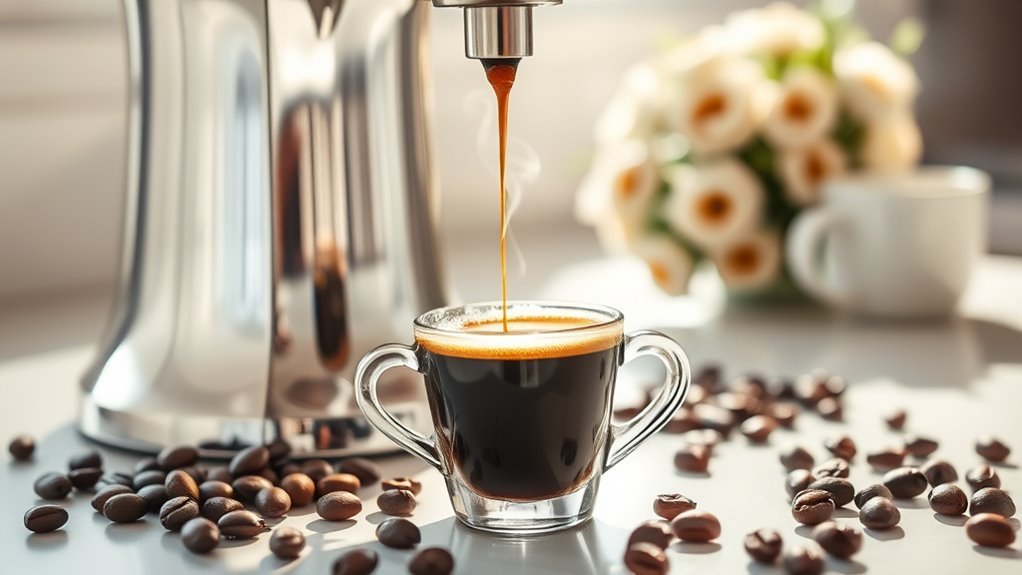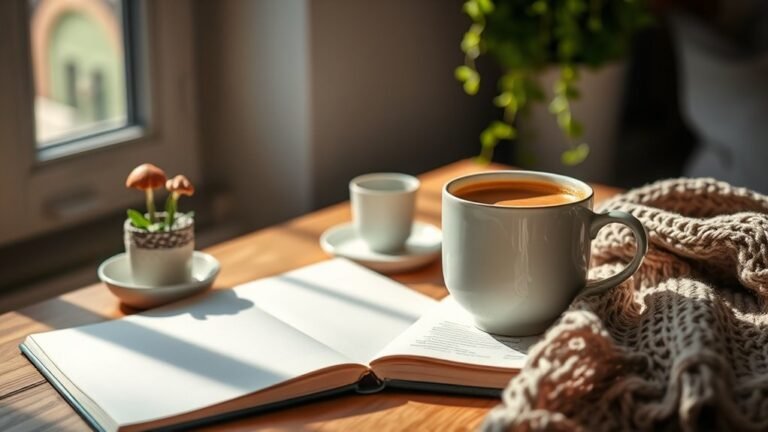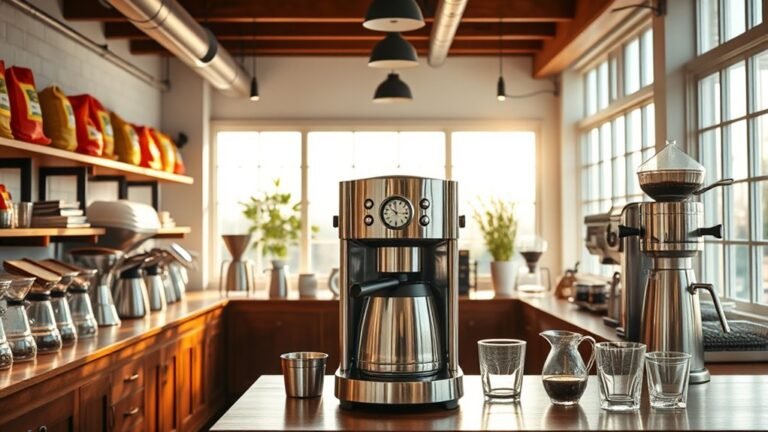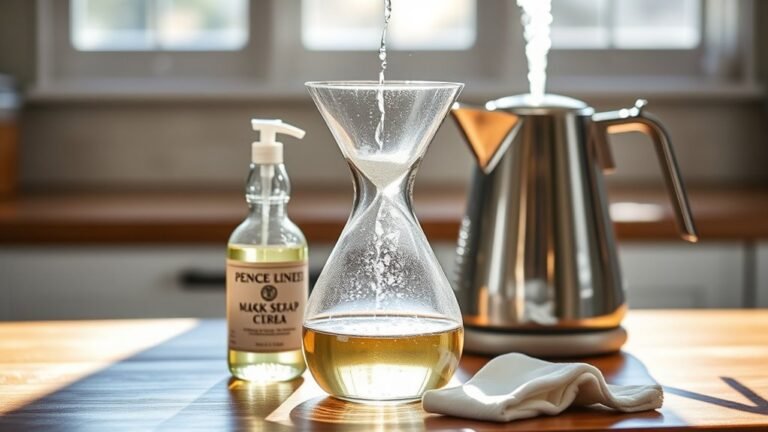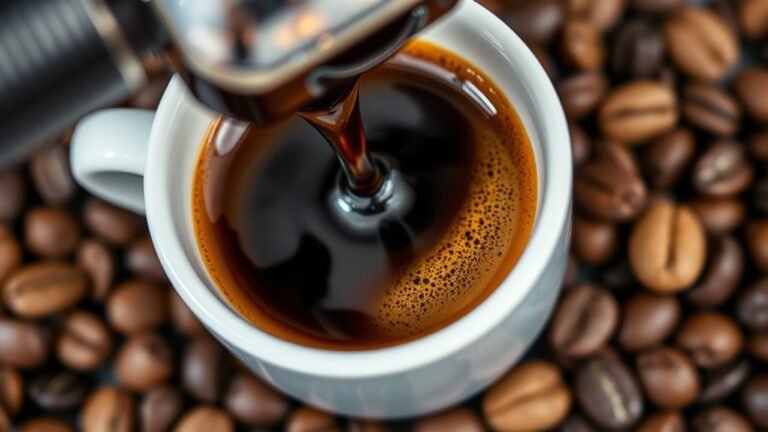Can I Make Espresso in a Coffee Maker
You can’t make true espresso in a traditional drip coffee maker. Espresso requires specific conditions, like around 9 bars of pressure and temperatures between 190°F to 205°F, which drip makers can’t achieve. While you can create coffee that’s similar in strength by using finely ground coffee and alternative methods, it won’t have the exact flavor profile or crema of espresso. If you want to explore other brewing techniques and tips for espresso-like coffee, there’s more to uncover.
Understanding Espresso and Its Characteristics
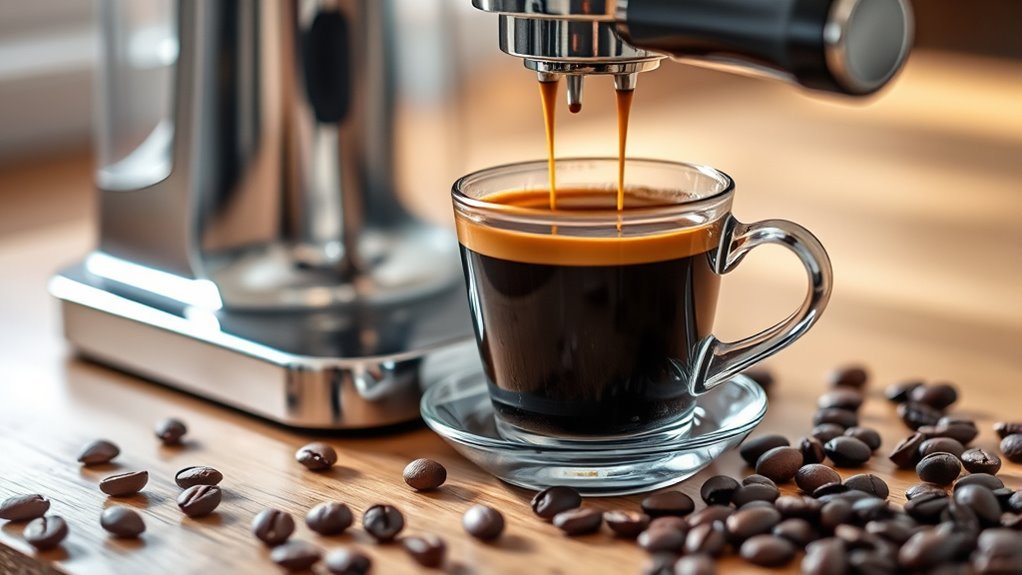
Espresso, often regarded as the heart of coffee culture, is a concentrated coffee beverage brewed by forcing hot water through finely-ground coffee beans. Its origin can be traced back to Italy in the early 20th century, where the espresso machine was invented to create a quick and rich coffee experience. Understanding espresso characteristics is essential for any coffee enthusiast. It boasts a robust flavor profile, with a thick, creamy layer of crema on top, indicative of high-quality extraction. The brew has a higher concentration of caffeine compared to regular coffee, providing a bold kick. When you appreciate these elements, you not only savor espresso but also grasp its significance within the broader coffee landscape, celebrating the artistry of coffee preparation.
Types of Coffee Makers
When it comes to making espresso, the type of coffee maker you choose plays an essential role. Drip coffee makers, espresso machines, and pod coffee makers each offer unique features and brewing methods that can affect the final taste and quality of your espresso. Understanding these differences will help you select the right equipment for your coffee-making needs.
Drip Coffee Makers
Drip coffee makers are among the most popular types of coffee machines, known for their ease of use and consistent results. If you’re after convenience, they’re hard to beat. With a simple brewing process, you can set it up, push a button, and let it do the work while you enjoy your freedom. The brewing techniques for drip coffee involve water passing through ground coffee, extracting flavors efficiently. While you won’t achieve the high pressure needed for true espresso, you can experiment with grind sizes and brew times to enhance your drip coffee experience. Remember, the quality of beans also plays a vital role, so choose wisely for the best results. Enjoy the journey of discovering your perfect cup!
Espresso Machines
While many coffee enthusiasts appreciate the convenience of drip coffee makers, those seeking the rich, concentrated flavor of espresso often turn to dedicated espresso machines. These machines offer various espresso machine features, such as adjustable pressure settings and built-in grinders, allowing you to customize your brew. Understanding espresso brewing techniques is essential; for instance, the ideal extraction time is typically 25-30 seconds. With a quality espresso machine, you can achieve the perfect balance of flavor and crema. Additionally, some machines provide steam wands for frothing milk, enabling you to create lattes or cappuccinos at home. Investing in an espresso machine can empower you to explore coffee-making freedom, elevating your daily rituals with robust and satisfying espresso shots.
Pod Coffee Makers
Pod coffee makers have gained immense popularity in recent years, offering a convenient and efficient way to brew coffee at home. These machines simplify your morning routine, allowing you to enjoy a fresh cup with minimal effort. However, pod compatibility is essential; not all machines work with every brand of pods. This can limit your choices and affect the flavor profile you desire. When considering user experience, look for models that provide customizable brew strength and temperature settings, enhancing your control over the final product. While pod coffee makers may not replicate the complexity of traditional espresso machines, they offer a fast and hassle-free solution for coffee lovers seeking convenience without sacrificing quality.
The Science of Brewing Coffee
Understanding the science behind brewing coffee is essential for achieving the best flavor. You’ll need to take into account factors like pressure, temperature, and grind size, as each element greatly impacts the extraction process. By mastering these variables, you can enhance your coffee-making skills and enjoy a richer espresso experience.
Brewing Process Explained
As you explore the brewing process of espresso, it becomes vital to grasp the science behind extracting flavors from coffee grounds. Espresso extraction techniques focus on optimizing the interaction between water and coffee. The key factors include grind size, water temperature, and brewing time adjustments. A finer grind increases surface area, enhancing extraction, while too coarse can lead to under-extraction and bitterness.
Brewing time adjustments play an important role; typically, a shot of espresso takes around 25-30 seconds to brew. Deviating from this range can considerably affect flavor profiles. Understanding these elements allows you to manipulate variables for your desired taste, granting you the freedom to experiment and create a personalized espresso experience.
Pressure and Temperature Factors
The interplay of pressure and temperature is fundamental in espresso brewing, influencing flavor extraction and overall quality. Espresso requires specific pressure requirements—typically around 9 bars—alongside precise temperature control, ideally between 190°F and 205°F. When these factors align, you get a rich, balanced shot. High pressure forces water through the coffee grounds quickly, extracting oils and flavors that contribute to espresso’s signature crema. If the pressure is too low, you’ll end up with under-extracted, sour notes; too high, and bitterness prevails. Similarly, temperature fluctuations can lead to either over-extraction or under-extraction, impacting your drink’s complexity. Understanding and managing these variables is essential for achieving that perfect espresso shot, giving you freedom in your brewing journey.
Coffee Grind Size Importance
While you might not realize it, the grind size of your coffee beans plays a fundamental role in determining the quality of your espresso. Achieving the right grind consistency is essential for ideal espresso extraction. If your grind is too coarse, water flows through too quickly, resulting in weak flavors. Conversely, a grind that’s too fine can lead to over-extraction, producing bitter notes.
Here’s a quick reference table to help you understand:
| Grind Size | Extraction Time |
|---|---|
| Coarse | 25+ seconds |
| Medium-coarse | 20-25 seconds |
| Medium | 18-20 seconds |
| Medium-fine | 15-18 seconds |
| Fine | 10-15 seconds |
Investing time in perfecting your grind will elevate your espresso experience.
Choosing the Right Coffee Grounds
Choosing the right coffee grounds is essential for crafting a rich and flavorful espresso. Start with an espresso roast, as it’s specifically designed to bring out bold flavors when brewed under pressure. The roast level considerably impacts the taste, so opt for freshly roasted beans to guarantee maximum aroma and quality. Equally important is grind consistency; for espresso, you need a fine grind to facilitate proper extraction. Too coarse, and the water flows too quickly, resulting in a weak brew; too fine, and you risk over-extraction, leading to bitterness. Aim for a uniform grind size by using a burr grinder, which provides better control. By paying attention to these factors, you’ll set a solid foundation for a delicious espresso experience.
Brewing Techniques for Espresso-Like Coffee
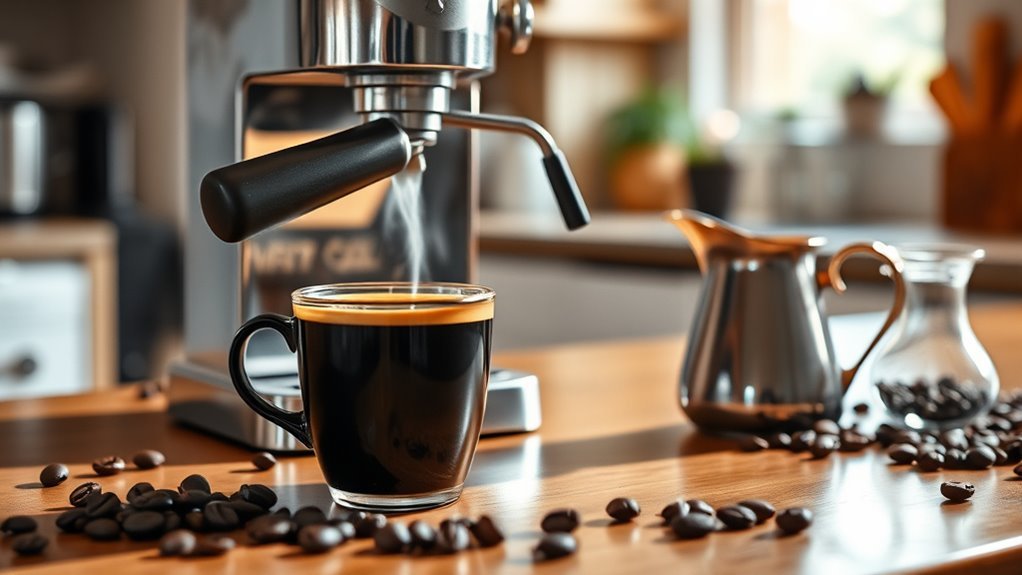
To brew espresso-like coffee at home, understanding the right techniques is essential, especially if you don’t have an espresso machine. Start by selecting finely ground coffee, as this enhances extraction and boosts coffee strength. Consider using a French press or AeroPress as espresso alternatives; both can generate rich flavors. For the French press, use a smaller amount of water to coffee ratio to achieve a concentrated brew. If you’re using an AeroPress, experiment with the inverted method to control pressure and extraction time, mimicking espresso’s intensity. Adjusting steeping time and pressure can help you perfect the flavor profile, allowing you to enjoy a bold cup that satisfies your espresso cravings without the need for specialized equipment.
Adjusting Water Temperature and Ratio
Achieving the right water temperature and ratio is essential for brewing a coffee that closely resembles espresso. Ideally, you want your water temperature to hover around 195°F to 205°F. Too hot, and you risk over-extraction, leading to bitterness; too cool, and you won’t extract enough flavor. Next, consider your brewing ratio—generally, a 1:2 ratio of coffee to water works well for espresso-like coffee. This means for every gram of coffee, use two grams of water. Adjust these variables according to your preferences, as finding that sweet spot can take some experimentation. Remember, it’s all about balancing the science of brewing with your personal taste to create a satisfying cup that brings you closer to that espresso experience.
Enhancing Flavor With Additives
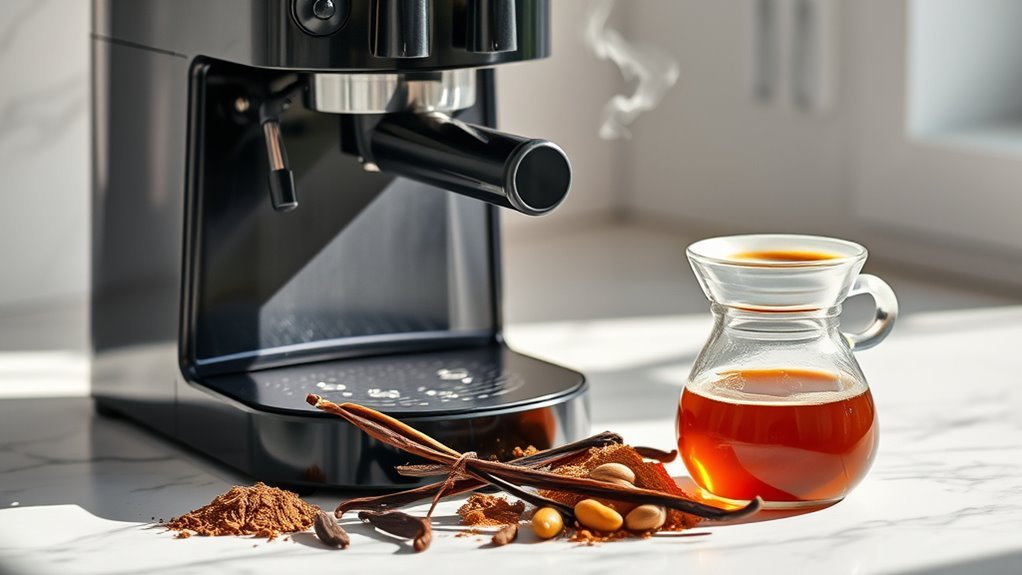
To elevate your espresso experience, consider incorporating various additives that can enhance flavor and aroma. Common enhancers like cinnamon or cocoa can create a richer profile, while thoughtful flavor pairings, such as vanilla with chocolate, can bring out the best in your brew. Don’t hesitate to experiment with different additives to discover unique combinations that suit your palate.
Common Espresso Enhancers
As you explore ways to elevate the flavors of your espresso, you’ll find that incorporating various enhancers can greatly transform your experience. Common espresso enhancers include syrups, spices, and flavored extracts, which can add depth to your espresso flavors. A popular choice is vanilla syrup, bringing a sweet and comforting note. Additionally, milk frothing is a fantastic method for enhancing your drink. By adding frothed milk, you create a creamy texture, balancing the robust flavors of the espresso. You might also consider experimenting with a sprinkle of cinnamon or cocoa powder, which can introduce an intriguing twist. These enhancers not only personalize your drink but also invite creativity, allowing you to craft a truly unique espresso experience.
Flavor Pairing Recommendations
While you might think of espresso as a finished product, the right flavor pairings can elevate its profile even further. By understanding various flavor profiles, you can enhance your espresso experience. For instance, adding a touch of cocoa or dark chocolate can introduce rich undertones that complement the inherent bitterness. A sprinkle of cinnamon or a dash of nutmeg can infuse warmth and spice, creating a cozy beverage. If you prefer a sweeter touch, consider vanilla or caramel syrup, which serve as excellent complementary ingredients, balancing acidity with sweetness. Remember, the key is to experiment with these pairings to discover which combinations resonate with your palate and elevate your espresso to new heights.
Experimenting With Additives
When it comes to enhancing the flavor of espresso, experimenting with various additives can lead to delightful discoveries. Additive experimentation allows you to personalize your brew and explore unique flavor combinations. Here are some options to contemplate:
- Vanilla extract: Adds a warm, sweet note.
- Cinnamon: Introduces a spicy depth and enhances sweetness.
- Cocoa powder: Brings a rich chocolatey essence.
- Nutmeg: Offers a subtle, aromatic twist.
- Sugar alternatives: Such as stevia or agave for a healthier sweetness.
Creating Espresso-Based Drinks
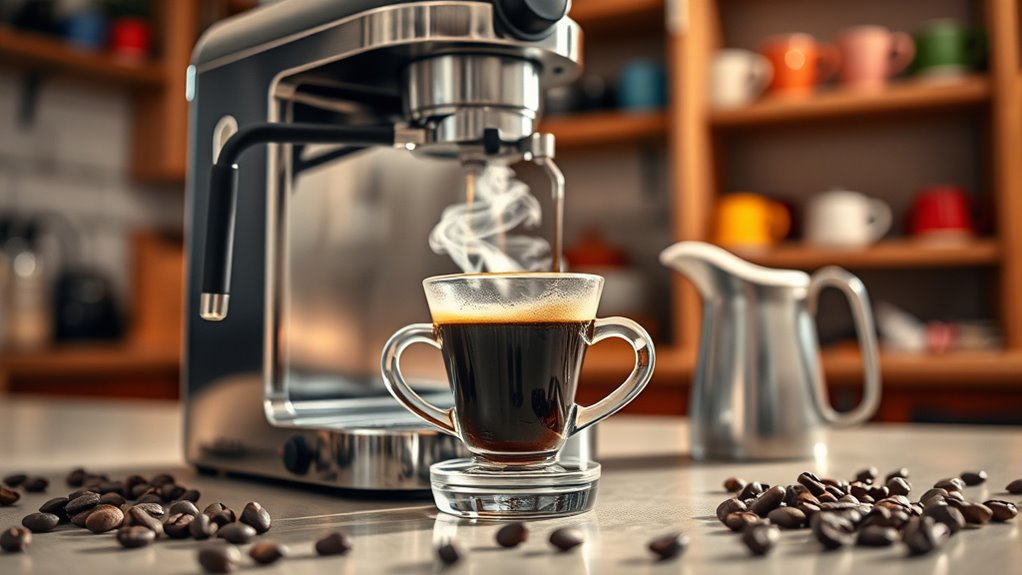
Creating espresso-based drinks opens a world of rich flavors and customizable options that cater to individual preferences. With a few essential techniques, you can elevate your coffee experience. Start by mastering the art of milk frothing; this skill allows you to create creamy textures for lattes and cappuccinos, enhancing the overall taste. Experiment with various espresso drinks, like macchiatos or mochas, to discover what suits your palate best. You can also adjust the espresso-to-milk ratio to achieve your desired strength. Don’t forget to ponder flavored syrups or spices for added complexity. By understanding these elements, you’ll gain the freedom to craft your perfect espresso drink, making each cup a personal masterpiece that reflects your unique taste.
Cleaning and Maintenance Tips
To maintain the longevity and performance of your coffee maker, regular cleaning and maintenance are essential. Establishing a maintenance schedule can help guarantee you’re always ready for that perfect espresso. Here are some effective cleaning techniques to incorporate:
- Rinse the brew basket and carafe after each use to prevent residue buildup.
- Use a mixture of vinegar and water to descale every month.
- Wash removable parts in warm, soapy water regularly for hygiene.
- Wipe down the exterior with a damp cloth to keep it looking new.
- Replace water filters as recommended to guarantee superior taste.
Exploring Alternative Brewing Methods
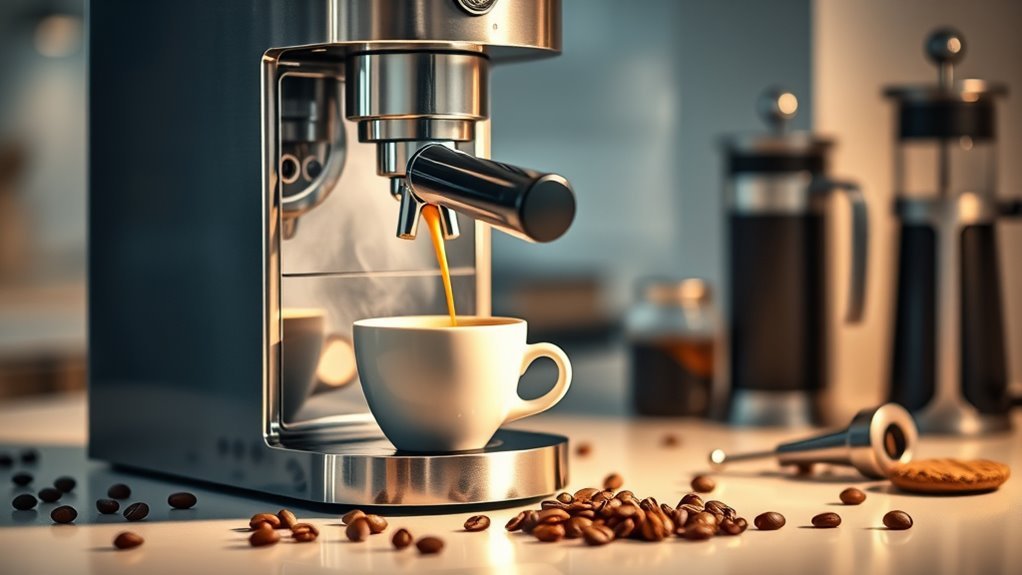
While many coffee enthusiasts swear by traditional espresso machines, exploring alternative brewing methods can uncover unique flavors and experiences that might surprise you. Embracing alternative methods not only enhances your coffee culture but also empowers you to experiment with different techniques. Here’s a comparison of some popular brewing alternatives:
| Method | Flavor Profile | Ease of Use |
|---|---|---|
| French Press | Bold and rich | Moderate |
| AeroPress | Smooth and balanced | Easy |
| Moka Pot | Strong and intense | Moderate |
| Pour Over | Clean and nuanced | Requires practice |
| Cold Brew | Smooth and sweet | Simple |
Frequently Asked Questions
Can I Use Regular Coffee Beans for Espresso?
You can use regular coffee beans for espresso, but there are nuances to contemplate. The espresso flavor largely relies on the roast and grind size. Espresso typically requires a fine grind and darker roasts, enhancing its bold profile. While brewing methods differ, using standard beans can yield varying results. If you enjoy experimenting, you might find that certain regular beans can create a satisfying espresso-like experience, albeit with unique characteristics.
Is Espresso Stronger Than Brewed Coffee?
When comparing espresso to brewed coffee, you’re often looking at espresso intensity versus coffee flavor. Espresso is concentrated, delivering a robust shot with a higher caffeine per ounce. While brewed coffee can be milder, it typically contains more caffeine overall due to larger serving sizes. So, if you prefer a punchy flavor experience, espresso might be your go-to. However, brewed coffee offers a different, often more nuanced taste that many enjoy.
How Long Does Espresso Take to Brew?
You might think espresso takes a long time to brew, but it’s quite the opposite. The brew time is typically around 25 to 30 seconds, thanks to the focused extraction process that forces hot water through finely-ground coffee under high pressure. This method not only maximizes flavor but also creates that rich crema on top. Understanding this quick brewing technique can help you appreciate the artistry behind each shot of espresso.
Can I Froth Milk Without an Espresso Machine?
Yes, you can froth milk without an espresso machine using several non-machine methods. A simple way is to heat the milk and then whisk it vigorously or use a French press to pump air into the milk. Another option is to shake heated milk in a jar until frothy. These techniques allow you to enjoy creamy, frothed milk in your drinks, giving you the freedom to create café-style beverages at home.
What’S the Difference Between Espresso and Coffee?
When you compare espresso and coffee, you’re looking at different brewing methods. Espresso brewing uses high pressure to extract concentrated flavors and oils from finely ground coffee, resulting in a rich, intense shot. In contrast, coffee extraction typically involves a slower process using coarser grounds, yielding a milder taste. While both start with coffee beans, the techniques and equipment create distinct experiences, allowing you to choose based on your personal preference for intensity and flavor.
